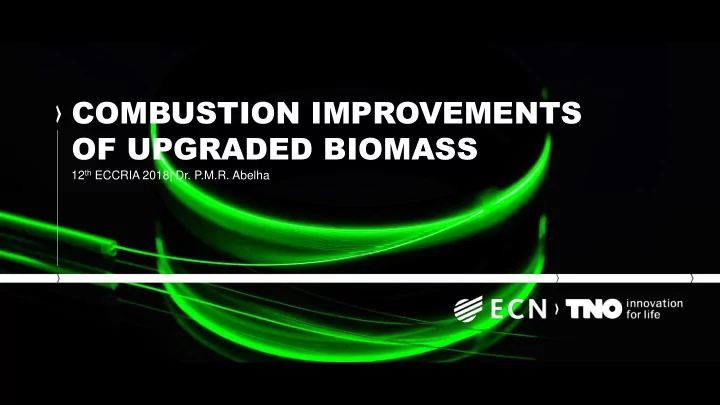

COMBUSTION IMPROVEMENTS OF UPGRADED BIOMASS 12 th ECCRIA 2018| Dr. P.M.R. Abelha
SCOPE OF THE WORK Upgrade several low-grade biomass materials at lab-scale (washing and torrefaction): Tomato foliage Road-side grass Miscanthus Wheat straw Spruce bark Sunflower husks, etc… Promotes the interest for low-cost alternative biomass sources Enhances energy density, homogeneity, hydrophobicity, grindability, transport, etc. Reduces alkalis and chlorine contents Reduces equipment maintenance cost – corrosion, fouling, slagging 2 | Cardiff presentation
SCOPE OF THE WORK Produce representative upgraded biomass at pilot plant level Batches between 500-800 kg Lab-scale Combustion tests with the upgraded biomass at pilot plant level Emissions, slagging and fouling 3 | Cardiff presentation
MATERIALS • List of feedstocks – Empty Fruit Bunches – Miscanthus – Sun flower husk – Road side grass – Wheat straw – Spruce bark – Tomato foliage 4 | Cardiff presentation
METHODS Variables: Liquid/Solid ratio (L/S) Temperature To pilot-scale! From lab scale… Time 10-50 g per batch 4 material selected 2 kg per batch 5 | Cardiff presentation
RESULTS (UPGRADING) Higher heating contents Limited mass loss High energy yields (> 85%) 6 | Cardiff presentation
RESULTS (UPGRADING) Combined effect of washing and torrefaction: Removal of 90-95% Cl, 50-80% K, 30-60% S and 30% P Torrefaction has limited effect in Cl removing Torrefaction has no effect in K removing 7 | Cardiff presentation
RESULTS (CHARACTERISATION) Ultimate and wheat straw, miscanthus, spruce bark, RSG, wheat straw miscanthus spruce bark RSG upgraded upgraded upgraded upgraded proximate analysis ash content (550°C) [wt.-%, dry] 10.3 9.3 2.1 3.1 3.4 4 18.1 14.8 ash content (815°C) [wt.-%, dry] 10.2 8.8 2 2.8 3.2 3.5 16.9 14.1 (RSG = road side volatile matter [wt.-%, dry] 71.8 70.9 81.7 75.7 74.5 69.2 66.1 61.5 moisture [wt.-%, ar] 1.6 3 1.5 1.5 0.5 0.5 1 1.5 grass) HHV [MJ/kg, dry] 17.5 19.2 19.3 20.4 19.9 21.5 16.5 20 carbon [wt.-%, dry] 42.9 47.7 47.7 50.1 49.4 54.3 41.4 49.9 nitrogen [wt.-%, dry] 0.4 0.4 0.3 0.2 0.4 0.4 1.8 1.7 hydrogen [wt.-%, dry] 5.6 5.5 5.9 5.6 5.8 5.6 5.3 5.3 oxygen [wt.-%, dry] 38.6 35.9 43.3 38.9 40.2 36.2 35.4 30.7 chlorine [mg/kg, dry] 2800 540 1300 420 100 88 9500 1300 Al [mg/kg, dry] 45 180 79 160 470 580 1700 1400 B [mg/kg, dry] 1.8 2 1.9 12 11 11 40 15 Ba [mg/kg, dry] 0.73 6.8 8.2 4.4 220 250 25 33 Ca [mg/kg, dry] 2800 3800 1000 1700 11000 14000 18000 13000 Fe [mg/kg, dry] 49 250 61 330 280 370 1800 1400 K [mg/kg, dry] 8400 3400 2300 1800 2000 1000 17000 4400 Mg [mg/kg, dry] 560 560 360 420 810 850 2000 1600 Mn [mg/kg, dry] 17 42 22 15 650 680 530 140 Na [mg/kg, dry] 140 440 260 470 160 500 1600 1000 P [mg/kg, dry] 830 610 220 250 510 430 4000 2200 S [mg/kg, dry] 820 520 480 360 330 310 3400 1400 Si [mg/kg, dry] 36000 34000 6500 14000 1900 2300 45000 46000 Sr [mg/kg, dry] 11 23 5.3 10 44 55 91 55 Ti [mg/kg, dry] 350 41 220 18 120 87 930 220 Zn [mg/kg, dry] 6.4 29 9.1 50 140 170 39 78 8 | Cardiff presentation
RESULTS (COMBUSTION) 9 | Cardiff presentation
RESULTS (COMBUSTION) NOx Primary NOx – volatiles combustion Secondary NOx – char combustion Upgrading doesn’t increase NOx emissions Higher NOx for grass, but still with margin for primary NOx reduction Upgraded miscanthus leaded to the lower NOx emissions 10 | Cardiff presentation
RESULTS (COMBUSTION) High temperature corrosion risk (Cl content) Miscanthus and Bark with lower Cl contents gave lower Cl emissions Upgrading decreases significantly the Cl contents and therefore the Cl emissions No significant high temperature chlorine corrosion is expected after upgrading. Exception: upgraded grass (Cl > 50 mg/MJ) 11 | Cardiff presentation
RESULTS (COMBUSTION) Submicron particles (Pilat Mark V cascade impactor ) Upgrading: Clear decrease in the sub-micron particles emissions for all biomasses Expected reduction in fouling tendency as well 12 | Cardiff presentation
RESULTS (COMBUSTION) Sub-micron particles Reduction in sub-micron particles, by mass Wheat straw 66.8% Miscanthus 78.3% Spruce bark 44.4% Road side grass 64.6% 13 | Cardiff presentation
RESULTS (COMBUSTION) Fouling probe Upgrading: Clear decrease in fouling of heat transfer surfaces for all biomasses, although for bark only small decrease. 14 | Cardiff presentation
RESULTS (COMBUSTION) Slagging probe (near burner conditions) SEM micrographs 15 | Cardiff presentation
RESULTS (COMBUSTION) SEM micrographs Slagging probe 16 | Cardiff presentation
CONCLUSIONS Low-grade biomasses like grass, straw, miscanthus and bark were upgraded by washing and torrefaction with success. The upgraded biomasses showed good properties for energy use applications; lab and pilot scale results are consistent. About 90-95% of Cl, 50-80% K, 30-60% S and 30% P can be removed during upgrading. Wash step crucial to the removal of K. Post-wash seems to be a viable route to upgrade dry-type biomasses. 17 | Cardiff presentation
CONCLUSIONS NOx emissions are not a matter of concern for the fuels under investigation. Exception: road side grass. Fine particulate matter (submicron/aerosols) formation is strongly reduced by upgrading the fuels, effectively reducing the risk of alkali induced fouling. High temperature chlorine corrosion can be effectively mitigated. Exception: road side grass, still exposes some corrosion risk. Slagging tests revealed that pre-washing and torrefaction has minor impact on the slagging propensity of the fuel. Only, slightly reduced slagging is observable. Recommendation: use mineral combustion additives, or smart blending with other fuels in order to further mitigate the slagging risks. 18 | Cardiff presentation
ACKNOWLEDGEMENTS Research funded by the Dutch Ministry of Economic Affairs (Tender 1 BBE – KEW project TEBE214004). This project has received funding from the European Union’s Horizon 2020 research and innovation programme under grant agreement No 727616. 19 | Cardiff presentation
THANK YOU FOR YOUR ATTENTION TNO.NL/ECNPARTOFTNO
Recommend
More recommend